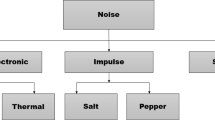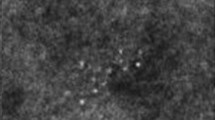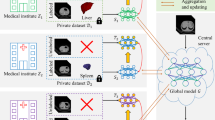Abstract
With the rapid development of medical imaging methodologies, such as magnetic resonance (MR) and positron emission tomography (PET)/MR, various types of MR images, which are acquired using inconsistent MR pulse sequences on the same patient, have been applied in medical-image-based diagnoses. A feature map extracted from an MR image describes the patient’s condition from one perspective. By effectively using all feature maps from various MR images, it is possible to completely describe the intrinsic characteristics of the patient’s condition to facilitate a diagnosis. Facing such a scenario, classic machine learning algorithms typically stack these feature maps for unified processing and do not explore the importance of each feature within a single feature map or the relationships among feature maps. To address these challenges, both multiview and subspace learning scenarios are considered in this study, and the multiview collaboration-based fuzzy soft subspace clustering (MVC-FSSC) algorithm is proposed. The MVC-FSSC algorithm not only strives to exploit the agreement of decisions across all views via collaborative learning but also strives to utilize the soft subspace-based weighting mechanism to automatically evaluate the contribution of each dimensional feature to each estimated cluster within a single view. Our experimental results indicate that the proposed MVC-FSSC algorithm can effectively explore the collaborative relations among all views and the importance of features in their respective views. Additionally, our MVC-FSSC method has substantial advantages over traditional clustering algorithms in MR image segmentation. Applying the MVC-FSSC algorithm to five patients’ MR images, the average mean absolute prediction deviation (MAPD) is 98.62 ± 8.34, which is significantly better than the score of 131.90 ± 16.03 that was obtained using the collaborative fuzzy k-means (CO-FKM) algorithm and the score of 128.87 ± 11.32 that was obtained using the quadratic weights and Gini-Simpson diversity-based fuzzy clustering (QWGSD-FC) algorithm.




Similar content being viewed by others
References
Aggarwal CC, Wolf JL, Yu PS et al (1999) Fast algorithms for projected clustering. ACM SIGMOD Rec 28(2):61–72
Aggarwal CC, Yu PS (2000) Finding generalized projected clusters in high dimensional spaces. ACM 29(2):70–81
Batuwita R, Palade V (2012) Adjusted geometric-mean: a novel performance measure for imbalanced bioinformatics datasets learning. J Bioinforma Comput Biol 10(04):1250003
Bezdek JC, Ehrlich R, Full W (1984) FCM: the fuzzy c -means clustering algorithm. Comput Geosci 10(2):191–203
Cao Y, Wu J (2002) Projective ART for clustering data sets in high dimensional spaces. Neural Netw 15(1):105–120
Chitsaz E, Jahromi MZ (2016) A novel soft subspace clustering algorithm with noise detection for high dimensional datasets. Soft Comput 20(11):4463–4472
Cleuziou G, Exbrayat M, Martin L, Sublemontier JH (2009) CoFKM: A centralized method for multiple-view clustering. IEEE Int Conf Data Min 752–757
De Soete G (1986) Optimal variable weighting for ultrametric and additive tree clustering. Qual Quant 20(2-3):169–180
Deng Z, Choi KS, Chung FL, Wang S (2010) Enhanced soft subspace clustering integrating within-cluster and between-cluster information. Pattern Recogn 43(3):767–781
Desgraupes B (2013) Clustering indices. University of Paris Ouest-Lab Modal’X 1:34
Domeniconi C, Gunopulos D, Ma S et al (2007) Locally adaptive metrics for clustering high dimensional data. Data Min Knowl Disc 14(1):63–97
Gao Y, Maggs M (2005) Feature-level fusion in personal identification. Comput Soc Conf Comput Vis Pattern Recognit 1:468–473
Hooijmans MT, Dzyubachyk O, Nehrke K et al (2015) Fast multistation water/fat imaging at 3T using DREAM-based RF shimming. J Magn Reson Imaging 42(1):217–223
Hotho A, Maedche A, Staab S (2002) Ontology-based text document clustering. KI 16(4):48–54
Jiang Y, Chung FL, Wang S et al (2015) Collaborative fuzzy clustering from multiple weighted views. IEEE Trans Cybern 45(4):688–701
Li RP, Mukaidono M (1995) A maximum-entropy approach to fuzzy clustering. IEEE Int Conf Fuzzy Syst 4:2227–2232
Liang F, Qian P, Su KH et al (2018) Abdominal, multi-organ, auto-contouring method for online adaptive magnetic resonance guided radiotherapy: an intelligent, multi-level fusion approach. Artif Intell Med 90:34–41
Liu J, Mohammed J, Carter J et al (2006) Distance-based clustering of CGH data. Bioinformatics 22(16):1971–1978
Loeff N, Alm CO, Forsyth DA (2006) Discriminating image senses by clustering with multimodal features. ACL Main Conf Poster Sess 547–554
Miyamoto S, Umayahara K (1998) Fuzzy clustering by quadratic regularization. IEEE World Congress Comput Intell 2:1394–1399
Nie F, Xu D, Li X (2012) Initialization independent clustering with actively self-training method. IEEE Trans Syst Man Cybern Part B (Cybernetics) 42(1):17–27
Parsons L, Haque E, Liu H (2004) Subspace clustering for high dimensional data: a review. ACM Sigkdd Explor Newsl 6(1):90–105
Qian P, Sun S, Jiang Y et al (2016) Cross-domain, soft-partition clustering with diversity measure and knowledge reference. Pattern Recogn 50:155–177
Rokach L (2009) A survey of clustering algorithms. Data Min Knowl Disc Handb 269–298
Roth HR, Shen C, Oda H et al (2018) Deep learning and its application to medical image segmentation. Med Imaging Technol 36(2):63–71
Sim K, Gopalkrishnan V, Zimek A, Cong G (2013) A survey on enhanced subspace clustering. Data Min Knowl Disc 26(2):332–397
Su KH, Hu L, Stehning C et al (2015) Generation of brain pseudo-CTs using an undersampled, single-acquisition UTE-mDixon pulse sequence and unsupervised clustering. Med Phys 42(8):4974–4986
Tzortzis G, Lika A (2012) Kernel-based weighted multi-view clustering. IEEE Int Conf Data Min 675–684
Wang G, Li W, Zuluaga MA et al (2018) Interactive medical image segmentation using deep learning with image-specific fine tuning. IEEE Trans Med Imaging 37(7):1562–1573
Wang G, Liu Y, Xiong C (2015) An optimization clustering algorithm based on texture feature fusion for color image segmentation. Algorithms 8(2):234–247
Xiaopeng W, Shihe H, Hui Y, Wen Z (2014) The design of medical image transfer function using multi-feature fusion and improved k-means clustering. J Chem Pharm Res 6(7):2008–2014
Xue Z, Li G, Wang S, Zhang C, Zhang W, Huang Q (2015) GOMES: A group-aware multi-view fusion approach towards real-world image clustering. IEEE Int Conf Multimed Expo 1–6
Zaidi H, Ojha N, Morich M et al (2011) Design and performance evaluation of a whole-body ingenuity TF PET–MRI system. Phys Med Biol 56(10):3091
Zhao K, Zhou L, Qian P et al (2019) A transfer fuzzy clustering and neural network based tissue segmentation method during PET/MR attenuation correction. J Med Imaging Health Inf. Accepted
Acknowledgements
This work was supported in part by the National Natural Science Foundation of China under grants 61772241 and 61702225, the Natural Science Foundation of Jiangsu Province under grant BK20160187, the Fundamental Research Funds for the Central Universities under grant JUSRP51614A, the 2016 Qinglan Project of Jiangsu Province, the 2016 Six Talent Peaks Project of Jiangsu Province, and the Science and Technology Demonstration Project of Social Development of Wuxi under grant WX18IVJN002.
Author information
Authors and Affiliations
Corresponding author
Additional information
Publisher’s note
Springer Nature remains neutral with regard to jurisdictional claims in published maps and institutional affiliations.
Rights and permissions
About this article
Cite this article
Zhao, K., Jiang, Y., Xia, K. et al. View-collaborative fuzzy soft subspace clustering for automatic medical image segmentation. Multimed Tools Appl 79, 9523–9542 (2020). https://doi.org/10.1007/s11042-019-07974-7
Received:
Revised:
Accepted:
Published:
Issue Date:
DOI: https://doi.org/10.1007/s11042-019-07974-7




